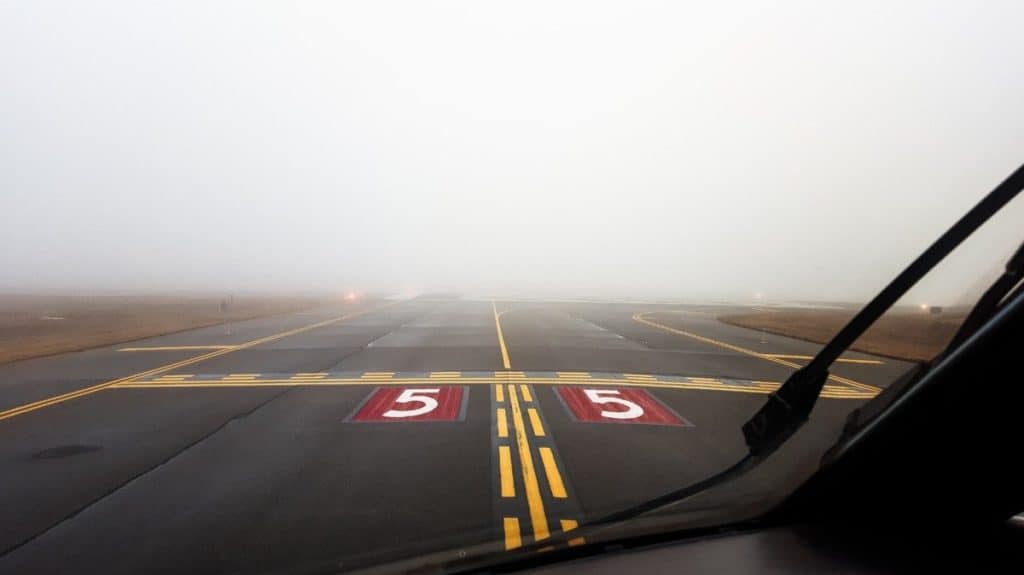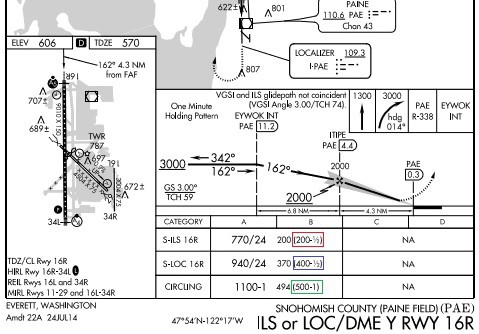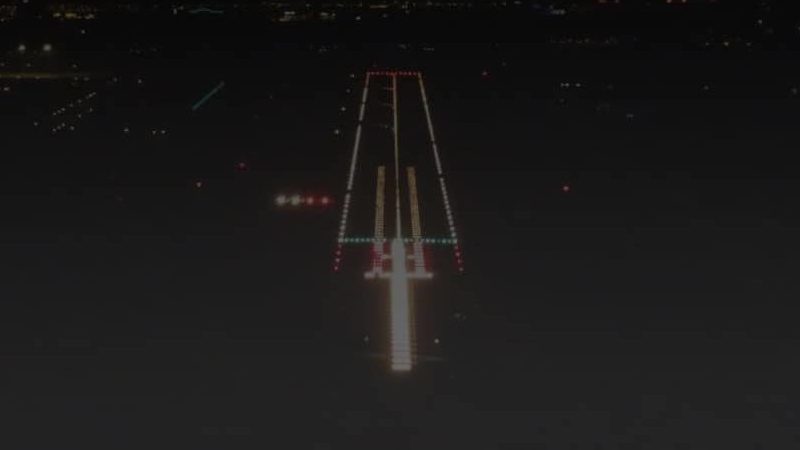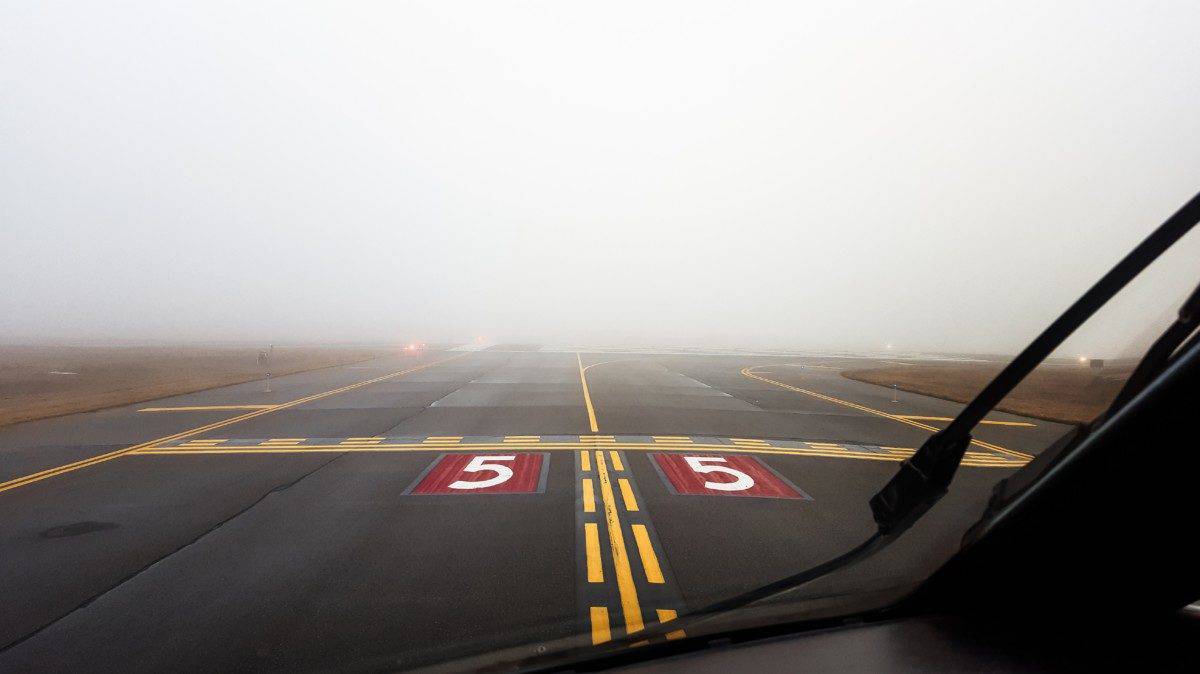
Your friend tells you about a recent trip where he was descending into Boston Logan Intl’ (KBOS) and as the airplane descended towards the runway, he could not see anything out his window except thick fog enveloping the airplane.
The aircraft descended lower and lower until out of nowhere he saw the runway edge lights and within seconds the aircraft touched down! After hearing his story, you start to wonder, can airplanes land in fog and if so, how do they do that?
Airplanes are able to land in fog & reduced visibility conditions by utilizing a runway’s instrument approach system, approach lighting, and pilot training. These systems guide the aircraft down a navigation funnel and allow the pilots to land once they see lights, runway, or autoland, if equipped.
In this article, we’ll look at some of the technology and procedures used by pilots to help them during landing in fog and reduced visibility conditions like snow storms, sand storms, low clouds, and heavy rain.
Can All Pilots Fly In Fog?
Safe flight into fog can only be achieved if the pilot is certified, trained and their aircraft are equipped with the required navigation and radio equipment. This is known as flying under IFR – Instrument Flight Rules and is what all the airlines & corporate aircraft fly under with the help of ATC.
The second type of flight rule is known as VFR – Visual Flight Rules, and this requires the pilot to remain in visual contact with the ground and/or horizon at all times. Flight into fog or reduced visibility usually ends in tragedy as most of these pilots are not trained to fly using sole reference to their aircraft’s instrumentation like the IFR pilots.
To be able to land at an airport there are two weather phenomenons that dictate whether the pilot can land:
- Cloud/Ceiling Height
- Forward Visibility
The ceiling will dictate at what altitude the pilot will break out of the clouds to be able to see the runway and land, and the forward visibility will determine how far down the runway a pilot can see as they approach to land. Fog is what commonly affects the forward visibility of a pilot.
Can Fog Stop Pilots From Landing?
When flying under IFR conditions the pilot will be under the guidance of an air traffic controller (ATC). For a pilot to commence an approach to their destination runway the air traffic controller has to issue them clearance to do so.
For that clearance to be issued the air traffic controller has to ensure the forward visibility along the runway is above the minimum threshold set forth when that instrument approach was designed and approved for that particular runway.
On each instrument approach procedure publication, the minimum forward visibility is stated based on the type of instrument approach technology the pilot is using to land. Precision approaches allow pilots to land in lower weather minimums compared to pilots flying a non-precision approach into the same runway.
Runways can have a mix of precision and non-precision approaches attached to them.

The image above is the lower portion of an Instrument Approach Procedure that a pilot uses when planning their approach into Runway 16R at Paine Field.
The 3 colored boxes tell the pilot what the ceiling and visibility must be to be able to land.
The S-ILS 16R is a precision approach allowing the pilot to land with a ceiling of 200 feet above the runway surface and forward visibility needs to be at least 1/2 statute mile. (Red Box)
The S-LOC 16R is a non-precision approach allowing the pilot to land with a ceiling of 400 feet above the runway surface and forward visibility needs to be at least 1/2 statute mile. (Blue Box)
The CIRCLING is a visual approach allowing the pilot to land with a ceiling of 500 feet above the runway surface and forward visibility needs to be at least 1 statute mile. (Green Box)
Depending on the type of equipment installed in the aircraft, the pilot will always choose the approach with the lowest weather minimums to increase their chances of being able to see the runway at the end of their approach.
All commercial airliners have the technology to complete a precision approach. Small, general aviation aircraft like Cessnas and Pipers may have the instrumentation to fly a precision approach or may only have the equipment to fly a non-precision approach.
For air traffic control to clear a pilot to begin their approach the forward visibility must be above the published minima for the approach being flown. The visibility can either be measured by a device located next to the runway or observed by the air traffic controller in the tower of the airport.
This device is called RVR – Runway Visual Range. It looks down the runway and measures how far a pilot could see if they were sat on the runway. Its data is given to the airport’s Tower Controller in meters.
RVR converts into the following:
| RVR in Meters | Feet | Statute Miles |
|---|---|---|
| 1800 | 6,000 | 1 1/8 |
| 1600 | 5,300 | 1 |
| 800 | 2,500 | 1/2 |
| 400 | 1,300 | 1/4 |
| 200 | 700 | 1/8 |
| 100 | 350 | 1/16 |
| 75 | 300 | Zero Visibility! |
Once the visibility drops below 1/2sm then RVR becomes the deciding number.
If the visibility is below the published minima, the air traffic controller can either:
- Invoke Reduce Visibility Operations at the airport if it is equipped with an Instrument Landing System and is approved for RVO
- Place the aircraft into a holding pattern in the hope that visibility will increase in the near future
- Divert the aircraft to another airport with better weather conditions.
Learn More…
Try These Articles:
* What Do Runway Markings and Numbers Mean?
* Can a Plane Land Itself?

Join My Newsletter & Get Great Tips, Information and Experiences To Help You Become a Superb Pilot!
How Can Airplanes Land In Fog?
Approaches are designed to guide pilots and their aircraft down to a point just before the start of the runway to enable a pilot to see and then land the aircraft when the weather is poor. Radio & satellite navigation funnels, intense approach lighting systems, and large painted runway markings aid in pilots landing.
The worse the weather conditions, the more systems a pilot needs to help them find the intended runway and land safely. The systems available to pilots attempting to land in poor weather are:-
- Runway Instrument Approach Navigation Technology
- Published Instrument Approach Procedures for that runway
- Runway Lighting System
- Runway Markings (Paint)
- Suitably Equipped Aircraft Technology
To Land an airplane in fog the pilot will go through the following process:
- Attain to the current weather information for the destination airport
- Attain/decide which runway is in use for landing aircraft
- Select the approach which will give them the lowest weather minima based on aircraft equipment
- Review the Instrument Approach Procedure for that runway
- Configure aircraft navigation and radio systems for the approach
- Get clearance for the approach from Air Traffic Control
- Intercept and begin flying the instrument approach
- As the pilot approaches the minima set in the procedure, begin looking for the approach lighting system
- Once lighting is attained, continue down past their Decision Height or Minimum Descent Altitude (Approach specific)
- Once runway surface or runway markings are seen prepare the aircraft for touchdown
Depending on the approach type, the decision height can be only 200 feet above the runway surface, and if the visibility is also down to 1/2SM that runway can appear very quickly! Pilots anticipate this so the airplane is configured for landing very early on in the approach so all the pilot/s have to do is see and land right at the last minute.
For modern airliners landing at larger international airports, the pilots can opt to use the aircraft’s autoland system in collaboration with a Cat II or III Instrument Landing System to allow the pilots to land the aircraft in practically zero visibility conditions!

Those airports must be equipped with an Instrument Landing System and depending on their category will allow commercial jets to autoland to land in the thickest of fog. RVR will dictate which category of ILS needs to be used and airports can only operate if they have the ILS category to match the visibility conditions.
There are 5 categories of ILS. The higher the category, the more accurately it can guide the aircraft:
| ILS Category | Decision Height | Min RVR |
|---|---|---|
| Cat I | 200ft | 500m |
| Cat II | 200-100ft | 300m |
| Cat III A | 100ft | 200m |
| Cat III B | 50ft | 75m |
| Cat III C | 0ft | 0m |
When a Cat III ILS system is in use the airport grinds to a crawl due to the reduced visibility of pilots trying to taxi. Airports enter into Reduced Visibility Operations which slows all traffic approaching to land, taxiing, and taking off.
What is the Difference Between a Decision Height and a Minimum Descent Altitude?
MDA – Minimum Descent Altitude
This is the lowest altitude the pilot can fly down to following a Non-Precision instrument approach navigation system. Upon reaching this altitude (as published on the instrument approach procedure for the runway) the pilot must level off, not descend below this and fly until they either see paint, pavement, or lights, or they reach the beginning of the runway, dictated by a time or GPS waypoint.
At this point, if they do not see anything they must initiate a Missed Approach procedure and climb away from the runway to try a second approach or divert to another airport.
DH – Decision Altitude
This is the lowest altitude the pilot can fly down to following a Precision instrument approach navigation system. Upon reaching this altitude (as published on the instrument approach procedure for the runway) the pilot must have visual confirmation of the approach lighting system, runway surface, or runway markings.
The pilot is allowed to momentarily descend through this height as it is a decision point, not a limit, and is usually 200-250ft above the runway. If the pilot sees the approach lights they can descend down to 100ft and at that point providing they can then see the runway pavement or runway markings they can land.
If the pilot/s do not see paint pavement or lights they too must initiate a Missed Approach Procedure and fly away.
For more information on an Instrument Landing System and how it works, check out:
Finding the Right Runway: How Do Pilots Know Where To Land?


